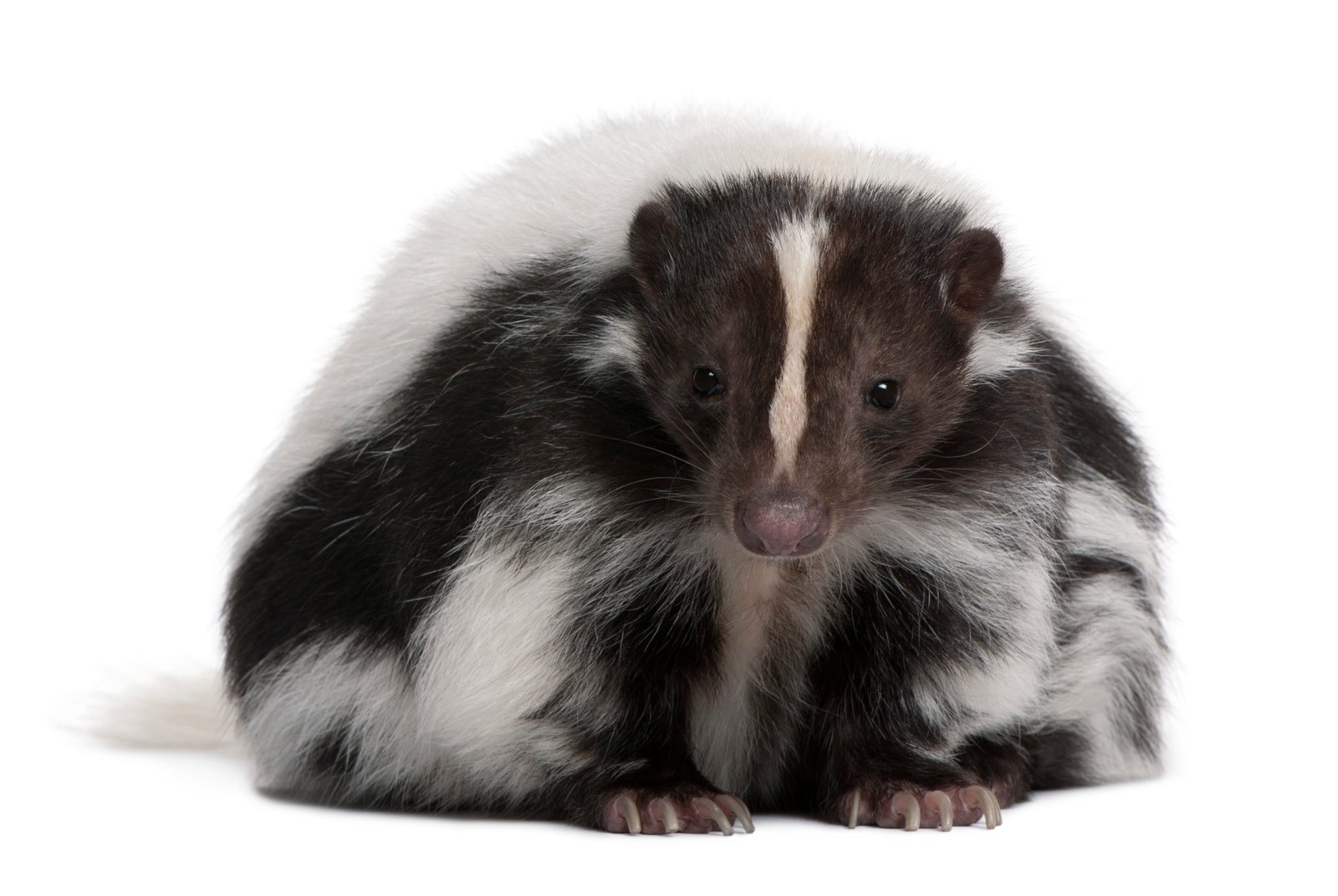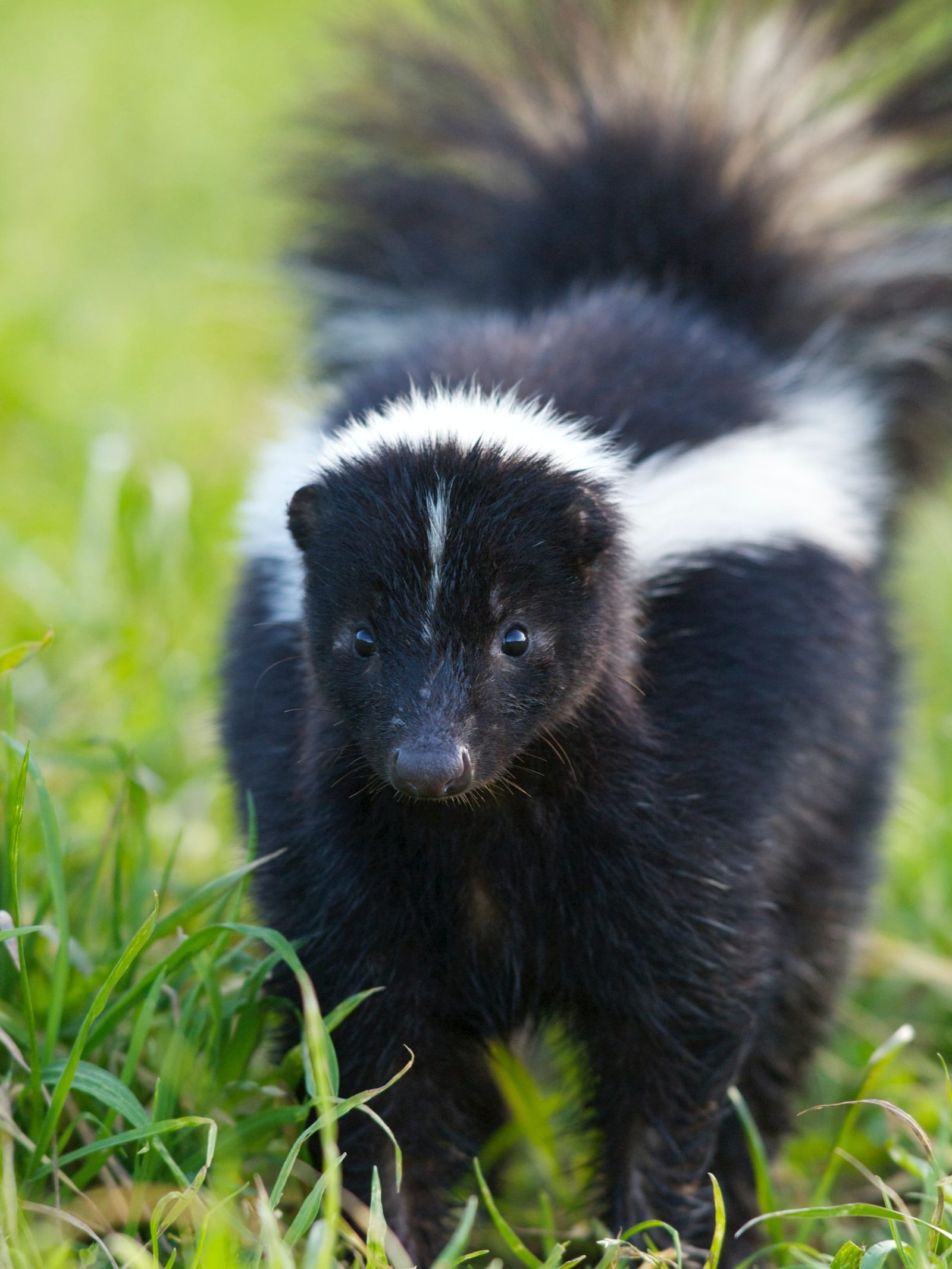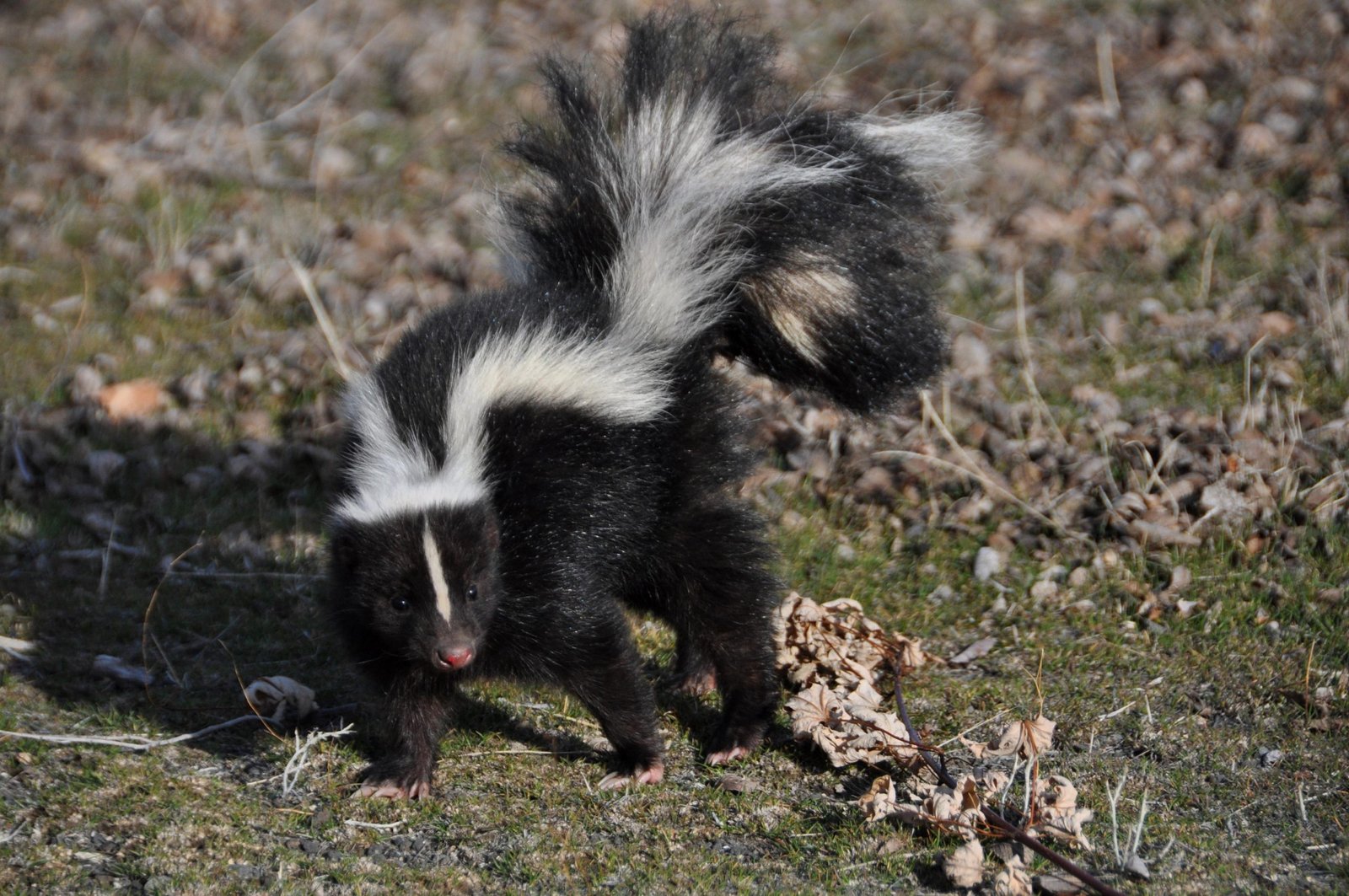Skunks Of North America

Skunk Description
Skunks are small, furry, black and white striped animals. Some skunks are lined, and some are spotted or have swirl patterns on their fur. A skunk’s white and black colored fur serves as a warning sign to predators who may harm this tiny creature. They’re known for this smelly defense mechanism and harmful odors generated from their we-developed scent glands.
Learn More: Nuisance Wildlife List
Average Skunk Size
Typically, skunks are around the size of house cats. They reach a length of 8 to 19 inches and weigh about 7 ounces to 14 lbs. Their tail adds to their length a further 5 to 15 inches.
Of all the skunk species, the Eastern hog-nosed skunk is the largest. It typically reaches between 27.56 and 31.50 inches and weighs between 4.41 and 9.91 lbs. 1Go To Source livescience.com -“Facts About Skunks”
Skunk Behavior

Skunks are docile creatures and, except for during the breeding season, often ignore other animals. Despite this animal’s passive nature, skunks are well equipped for defensive practices.
Skunks, although some may be crepuscular, is solitary and primarily nocturnal. Around twilight, circadian activity begins and may continue until daybreak. The animal will take refuge in other mammals’ abandoned underground dens during the daytime but may dig their own if necessary. It may also be possible to use hollowed logs or trees, rock or brush piles, and buildings’ underside.
This species undergoes a season shift, from aboveground living quarters (summer) to underground sites (winter), in areas with cold winter climates. Although skunks do not hibernate, they become inactive, relying on fat storage for energy during winter. It is common to see communal verification between females or even females and a single male during this time.
During the winter, they’re known to remain in a single den, but they may occupy multiple dens during warmer weather periods. No dormancy is experienced by individuals living in areas without a cold wintering period. 2Go To Source animaldiversity.org -“Mephitis mephitis striped skunk”
Skunk Defensive Spraying
Although all carnivores are known to have scent glands, members of the Mephitidae family have enlarged anal scent glands, even more than members of the Mustelidae family. There is an overpowering, yellowish musk in these paired glands, which can be released in a fluid spray through the anus, reaching up to 6.0 meters. The resulting mist can reach even further, and humans can detect the scent from an extremely long distance.
The musk functions as a sensory irritant and has been reported to cause nausea, severe pain, and temporary blindness. If approached, while arching its back and raising its tail, skunks will face an adversary, then use their forelegs to stomp the ground as a warning. If the ground stomping is done in tandem with backing away, a temporary handstand can be performed. A skunk will bend its hindquarters around while still facing the intruder and spray if the opponent does not comply by drawing back. A discharge can also result in impulse movements or noises.
Skunk Bites
Skunks have impressive teeth and are able to inflict severe bite wounds. Since skunks sparingly use their odiferous defensive spray, aggressors such as cats and dogs will frequently be bitten by skunks. These bites can transmit the deadly rabies virus.
Reproduction Of Skunks

Male skunks breed with several females and are rejected after mating by the females. Typically, female skunks give birth once every year, with breeding taking place between February and April.
In some cases, in the case of loss of the first litter, or pseudopregnancy, a secondary breeding period will occur in May. Delayed implantation lasting up to 19 days can occur in striped skunks. A litter of two to ten skunks is born after a gestation period of 59 to 77 days.
Offspring are born helpless, called kits or kittens, with eyes opening at about 3 weeks and weaning at about 6 to 7 weeks.
Once they are weaned, the young skunks in a single file line will follow their mother and learn to forage and hunt. Among skunks, there is a high mortality rate; many do not survive beyond their first year. At about 10 months, young striped skunks achieve sexual maturity. 3Go To Source nationalzoo.si.edu -“Striped skunk”
Skunk Habitat
The skunk species occupies various habitats, including under porches, decks, sheds or fields, forests, and suburban and urban locations.
The skunk can dig a burrow of its own that can reach three to four feet below the ground and six to 20 feet in length, ending in round chambers lined with leaves and grass. More often, a skunk will take over woodchucks or foxes’ burrows. 4Go To Source massaudubon.org -“About Skunks”
Range Of Skunks In North America
Different skunk species can be found in every U.S. state. Their ability to adapt to most environments (commonly suburban neighborhoods) allows skunks to find a home in almost any location. One of the only places that they cannot be found include the desert areas of Utah and Nevada.
Skunk Diet

Skunks tend to be opportunistic feeders, meaning they will alter their diet as needed. They are predominantly insectivorous during the warmer spring and summer seasons, known to feed on various grasshoppers, crickets, beetles, larvae, and social insects such as bees. Worms, crayfish, and other non-insect arthropods may include other invertebrates.
Over the wintering period, small mammals such as voles and young of ground-nesting birds are commonly consumed. Amphibians, reptiles, carrion, and fish are also known to be consumed by striped skunks.
While up to 80-90% of their diet is of animal origin, striped skunks are also known to feed on plant matter during summer seasons. Corn, nightshade, and fruits such as black and ground cherries are included in this. 5Go To Source biokids.umich.edu -“Striped skunk Mephitis mephitis”
Common Skunk Predators
- Mountain Lions
- Big Owls
- Dogs
- Bobcats
- Coyotes
- Badgers
- Foxes
Are Skunks A Nuisance Species?
Skunks become a nuisance when their feeding/burrowing habits cause headaches for people. They may burrow by entering foundation openings under porches or buildings. To search for insect grubs found in the soil, skunks dig holes in lawns, golf courses, and gardens. Digging appears, up to 3 to 4 inches in diameter, as small cone-shaped holes or up-turned earth patches.
In agricultural situations, skunks may also cause damage. Occasionally, for example, they feed on maize, take poultry or eggs, or damage beehives. Since many other animals cause similar damage, it is essential to try and identify the problem species before undertaking control measures. Skunk corn damage is characterized by damage to the lower ears while the stalk is still standing. Usually, they take only one or two people at a time when skunks kill poultry, and generally, they will not climb over fences. On one end, eggs are typically opened with the edges crushed inward. 6Go To Source extension.psu.edu -“Skunks – Solutions to Common Problems”
North American Skunk Species
- Spotted Skunk Spilogale putorius
- Striped Skunk Mephitis mephitis
Sources:
- —. “Facts About Skunks.” Livescience.Com, Future US, 22 June 2016, www.livescience.com/55151-skunks.html#:%7E:text=Skunks%20are%20small%2C%20furry%20animals,may%20harm%20this%20small%20creature.
- Kiiskila, J. 2014. “Mephitis mephitis” (On-line), Animal Diversity Web. Accessed January 21, 2021 at https://animaldiversity.org/accounts/Mephitis_mephitis/
- Smithsonian’s National Zoo and Conservation Biology Institute. “Striped Skunk.” Smithsonian’s National Zoo, Smithsonian’s National Zoo & Conservation Biology Institute, 8 May 2020, nationalzoo.si.edu/animals/striped-skunk#:%7E:text=There%20is%20a%20significant%20reduction,southern%20Canada%20into%20northern%20Mexico.
- “About Skunks.” Mass Audubon, Mass Audubon, www.massaudubon.org/learn/nature-wildlife/mammals/skunks/about-skunks. Accessed 21 Jan. 2021.
- Kiiskila, J. 2014. “Mephitis mephitis” (On-line), Animal Diversity Web. Accessed January 21, 2021 at http://www.biokids.umich.edu/accounts/Mephitis_mephitis/
- Brittingham, Margaret C. “Skunks – Solutions to Common Problems.” Penn State Extension, PSU, 16 Jan. 2021, extension.psu.edu/skunks-solutions-to-common-problems#:%7E:text=Skunks%20become%20a%20nuisance%20when,grubs%20found%20in%20the%20soil.
